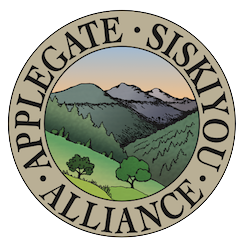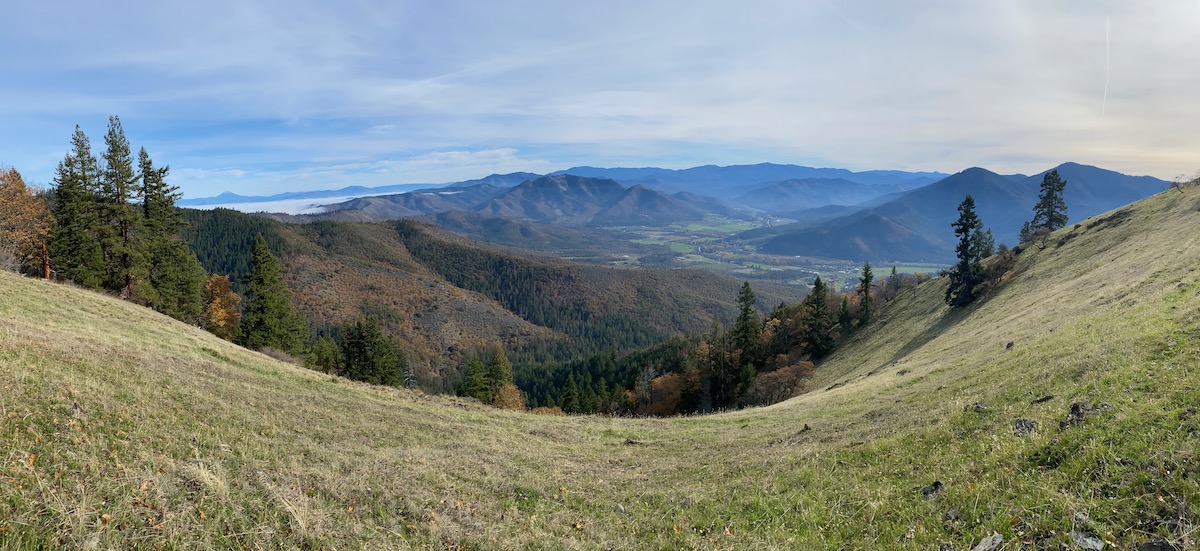
Starting in 2014, and for over two years Applegate Neighborhood Network (ANN) opposed the Nedsbar Timber Sale. The timber sale sprawled across the Little and Upper Applegate Valleys, including numerous unroaded units, late successional forests, and unique wildland habitats. Perhaps the most egregious units in the entire timber sale were located in old-growth forests on the southwest face of Bald Mountain. ANN and local community residents fought hard to protect Bald Mountain. We led public hikes, we attended BLM field trips, used social media to educate about the potential impact of logging in these beautiful old-growth stands, and in September 2016, we held protests outside the Nedsbar timber auction at the BLM Office in Medford, Oregon. Due in part to pressure from the community, the timber sale failed to sell at auction, the BLM withdrew the Nedsbar Timber Sale and Bald Mountain was spared.
Almost exactly three years later, the BLM has proposed the Bear Grub Vegetation Management Project. The preliminary project information released by the BLM identifies commercial timber production as an overriding objective and implementation is proposed to include a large commercial timber sale. Thus, we refer to the project as the Bear Grub Timber Sale.
The Bear Grub Timber Sale proposes three units within the citizen identified Bald Mountain Roadless Area. Located on the ridgeline of Bald Mountain these units are located on the northeast face of Bald Mountain in the Wagner Creek Watershed and directly above the town of Talent, Oregon.
Bald Mountain lies east of Anderson Butte and divides the Little Applegate Watershed from the Bear Creek Valley. Although the unroaded habitat is relatively small, Bald Mountain is a unique and special place. The area is important for the connectivity it provides between the Anderson Butte ridgeline, the foothills of the Applegate Valley, and the Siskiyou Crest near Wagner Butte.

The Bald Mountain area contains the historic Front Range Trail — now referred to as the Bald Mountain Trail — along the ridgeline of Bald Mountain. This old pack trail was used to connect fire lookouts on Wagner and Anderson Butte in the 1930s and is still used to this day by local hikers and residents in the area. It is also being proposed as a portion of the Jack-Ash Trail, which will ultimately connect the communities of Jacksonville and Ashland, Oregon. The first leg of the non-motorized Jack-Ash Trail has been constructed and many local residents support its completion.
The mountain is a spectacular mosaic of late successional forest, sweeping grasslands, thickets of serviceberry, groves of mountain mahogany and fringes of oak woodland. The area is dynamic and diverse. Located in the rainshadow of Dutchman Peak and Big Red Mountain, the area is relatively arid and sits right at the edge of the transient snow zone. Eastern species such western juniper (Juniperus occidentalis), large populations of rubber rabbitbrush (Chrysothamnus nauseosa) and even big sagebrush (Artemisia tridentata) grow here.

The southwest-facing slopes of Bald Mountain are among the most beautiful in all of the Applegate. These balds, or upland prairies ring the top of harsh south-facing exposures throughout the area. Spring wildflowers can be abundant and beautiful in these openings and the Bald Mountain area, includes both rare and endemic plant species such as Applegate stonecrop (Sedum oblanceolatum). The only Oregon population of the rare and endangered Siskiyou mariposa lily (Calochortus persistens) also grows on Bald Mountain.
Stringers of conifer forest hem in the grasslands and reach to the ridgetop. The forests on the southwestern face were proposed for logging in 2014 in the Nedsbar Timber Sale. On the ridgeline, dry conifer forest abruptly dominates and forested habitats spill down the north- and east-facing slopes draining into Wagner Creek. These old stands on the ridgeline of Bald Mountain are the last complex forest in the vast sea of clearcuts at the headwaters of Wagner Creek and around Wagner Gap. They are also proposed for logging in the Bear Grub Timber Sale.
Bear Grub, Unit 21-2

Unit 21-2 is located on a northeast-facing slope at the headwaters of Arrasta Creek on the flank of Bald Mountain, in the small but biologically significant Bald Mountain Roadless Area. The unit is located adjacent to the Bald Mountain Trail, a historic pack trail proposed as a section of the Jack-Ash Trail. Unit 21-2 contains mid to late successional forest habitat with relatively open groves of large Douglas fir and white fir. The stand contains many large, old-growth trees (Doug fir and white fir) and a sizeable population of the rare species, tall bugbane (Cimicifuga elata).
Located at over 5,000’ the stand is relatively moist and productive. The cool, moist microclimate created by large overstory trees and the protection associated with closed canopy forest habitat supports the largest population of tall bugbane in the Siskiyou Mountains. Nearly the entire unit is carpeted with dense, vibrant populations of tall bugbane, sword fern and Cascade Oregon grape.

Habitat for tall bugbane would be badly damaged by yarding operations, large tree removal and canopy reduction. It is likely that logging and yarding activity in this stand would directly kill hundreds if not thousands of tall bugbane plants. Stand desiccation, increased competition from regenerating shrubs and conifer saplings, canopy reduction, and other indirect impacts would have lasting impacts, leading to population declines and an increased likelihood of noxious weed spread.
Currently unit 21-2 is naturally very fire resistant, with large, well-spaced trees, high canopy layers, relatively moist microclimate conditions, lush understory conditions and minimal fuel loading. Logging this stand would significantly open the canopy, increasing solar radiation, introducing drying winds, and desiccating stand conditions. Canopy reduction would also trigger an aggressive understory response, regenerating dense shrubs and highly flammable conifer saplings. Young, fire-available fuels will fill canopy gaps, dramatically increasing fuels for between 5 and 50 years, or until canopy conditions recover and begin to suppress understory growth.

Finally, unit 21-2 clearly contains Nesting, Roosting and Foraging (NRF) habitat for the Northern spotted owl and high quality denning habitat for species such as the Pacific fisher. Commercial thinning prescriptions will likely reduce canopy cover and downgrade NRF habitat. These same prescriptions will also remove future snag and downed wood habitat, eliminate interlocking canopy structure and minimize habitat complexity in the long term.
Unit 21-2 should be withdrawn from the Bear Grub Vegetation Management Project. Commercial thinning prescriptions would have potentially negative impacts on fuel loading, late successional habitat, Northern spotted owl habitat, recreation and important rare plant populations.
Bear Grub, Units 27-4 & 27-8

Units 27-4 and 27-8 are located adjacent to each other on the northeastern slope of Bald Mountain in the Bald Mountain Roadless Area. Located in the headwaters of Reel Creek, above a vast swath of clearcuts and plantations stands, the unit is located in the last strip of complex forest in the heavily logged Reel Creek watershed. In some places the units are directly adjacent to the Bald Mountain Trail and the proposed route of the Jack-Ash Trail.
Units 27-4 and 27-8 are mid to late successional with groupings of large, old trees scattered throughout the stand. Relatively fire resistant, the stands contain a mixture of open spaced trees, high canopies, closed canopy conditions, and minimal understory fuel. Understory fuel loading is being actively suppressed by the intact canopy layer created by large, relatively open grown trees.

The stands contain important Nesting, Roosting & Foraging habitat for the Northern spotted owl and denning habitat for the Pacific fisher. The groupings of large, old trees and snags, the downed wood, complex canopy structure and interlocking canopies create important late successional habitats that should be retained.
Unit 27-4 extends to nearly the ridgeline and lies directly below the only population of Siskiyou mariposa lily (Calchortus persistens) in the state of Oregon. This lily is listed as an endangered species and could be affected by changes in microclimate associated with nearby logging. The species is also being encroached upon by off-road vehicle trails which should be immediately closed to all motorized use.

Commercial logging prescriptions in units 27-4 and 27-8 would reduce canopy cover, increase understory fuel loading, degrade the recreational experience of the proposed Jack-Ash Trail, negatively affect Northern spotted owls and Pacific fisher habitat, and increase fire risks.
Please join ANN in demanding that these egregious units be withdrawn from the Bear Grub Timber Sale! Contact the Medford District BLM and ask them to protect the proposed Jack-Ash Trail and the beautiful old forests of Bald Mountain by withdrawing units 21-2, 27-4, and 27-8 from the Bear Grub Vegetation Management Project.
Contact the BLM via email:
Medford District BLM, District Manager, Elizabeth Burghard eburghar@blm.gov
Medford District BLM, Environmental Planner, Lauren Brown lpbrown@blm.gov
Contact the BLM with a written letter:
District Manager, Elizabeth Burghard, 3040 Biddle Road, Medford, Oregon, 97504

